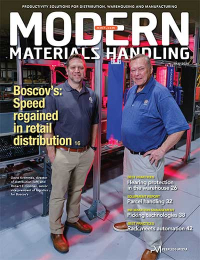Next steps in FedEx-USPS business relationship are uncertain with contract set to expire at end of September
Latest Material Handling News
The current state of the business relationship between Memphis-based freight transportation and logistics services provider FedEx and the United States Postal Service (USPS) received a fair amount of attention on the former’s fiscal second quarter earnings call late last year.
That was made clear on the call, with FedEx President and CEO Raj Subramaniam explaining that 2023 was what he called a “particularly difficult year” for the company’s Express unit, which saw revenue fall 6% annually to $10.2 billion, with operating income off 60% to $137 million. One reason for the loss, he explained, was related to USPS’s strategy to shift more of its volume handled by FedEx from air to ground, which Subramaniam viewed as a headwind.
The current contract between FedEx and USPS is set to expire on September 30, 2024, the end of the current fiscal year.
Like Subramaniam, FedEx Executive Vice President, Chief Customer Officer Brie Carere also labeled the current situation regarding USPS as a headwind.
“From a negotiation perspective, we are having very collaborative negotiations with the Post Office, but I think we've also been very clear that it will take quite a significant change in contractual terms and agreement to renew that contract,” she said on the December earnings call. “We continue to value the partnership. We're both at the table. And of course, we are honoring our service commitments. And with the current volume levels, that is a headwind this fiscal year. So, we're still negotiating. As soon as we have a renewed contract or a decision, we'll let all of you know. I am optimistic one way or the other we will improve the profit situation at Express regardless of our relationship with the Post Office.”
The shifting of USPS volume from air to ground in the FedEx network was evident in the 18% decline in total average daily freight pounds in the fiscal second quarter, which was impacted by the shift.
What’s more, the USPS continues to deal with ongoing revenue losses amid a series of steps it has taken in recent years to reduce them and eventually see a profit. Taking steps to counter that, it has cut back the total of volume it moves via air by 90% going back to 2021, according to Postmaster General Louis DeJoy, putting it on track to reduce approximately $1 billion from its annual air transportation costs.
As for FedEx, Subramaniam noted on its recent earnings call that its Express group was pressured by an ongoing volume mix-shift and related yield headwinds.
“Our ability to drive margin improvement in the near term has been constrained by transitory factors including the year-over-year decline in the US Postal Service volume, combined with minimum required service obligations associated with our current USPS contract,” he said.
But it is taking steps to augment operations through its DRIVE initiative, which includes Network 2.0, a years-long effort focusing on the operational efficiency, in which the company picks up, transports, and delivers packages in the U.S. and Canada.
He said that historically, the company’s global Air Network was primarily built on a hub-and-spoke system to support speed and global connectivity. But with the rapid growth of e-commerce, coupled with volume mix continuing to shift to deferred, it recognized the need to reconfigure its network to focus on both speed and density.
In February 2017, FedEx Express and the USPS extended their express air transportation contract, which was originally inked in April 2013, with the deal intact through September 29,2024. FedEx said that the modified contract was expected to generate revenue of approximately $1.5 billion per year for FedEx Express, with FedEx Express providing airport-to-airport transportation of USPS Priority Mail Express and Priority Mail within the United States.
And in May 2019, FedEx announced its plan to integrate FedEx Smart Post package volume, which have traditionally gone to the United States Postal Service for daily residential deliveries, into its FedEx Ground standard operations, as well as also increasing large package capabilities. The company said, at the time, this comprises nearly 2 million FedEx SmartPost packages, which will be more frequently integrated into its FedEx Ground operations and will be handled by the same service providers that are already handling its FedEx Ground residential packages.
John Haber, chief strategy officer for transportation and logistics services provider Transportation Insight, described the current situation between FedEx and the USPS as challenging.
“Everybody is looking at ways they can control costs and, outside contract carriers are expensive,” he said. “The post office has got to figure out a way to cut costs and so does FedEx. Both need to improve their profitability and their cost structure especially when you don't have the volume growth. You have revenue growing just because of rate increases and price increases if those stick.
Those rates stick in parcel because there is still not enough competition. But as the Post Office looks to how much they are spending on outside contract carriers, they are reassessing and that is bad news for the incumbents. FedEx does the same and outsources a lot. So does UPS. All the big players have to outsource. None of them have enough assets not to use contract carriers to some extent. They're examining the relationships they have and the pricing structures and how much they are competing in certain things. FedEx moves a lot of volume for USPS. It is an intricate web of relationships and politics. But anytime you see big changes like that, it means that there's big things to come.”
Jerry Hempstead, president of Orlando-based Hempstead Consulting said that Postmaster DeJoy has taken steps to make the USPS operate on schedule, explaining that with the decline in volumes, there is a lot of excess truck capacity.
And he added that DeJoy has focused on USPS network planning use the more financially appropriate routing on the ground network if service can be maintained.
“The USPS can make service on over half the business and keep the packages on the ground,” he said. “That leaves FedEx flying a lot of expensive empty container slots. So, the intelligent routing [of] USPS packages hurts FedEx in the pocket book. Either of two things are needed: find a way to move volume back over to FedEx (moving the empty space back to the USPS ground network) or charge more for what FedEx does for USPS. I’m sure UPS would love to hear from USPS as their volume is down considerably. FedEx has had this business a very long time. Losing the business would be very bad for FedEx as the business is so institutionalized in its network.”

Article Topics
FedEx News & Resources
Dexterity AI and FedEx unveil robotics trailer loading technology Berkshire Grey and FedEx expand their robotic automation solutions relationship American Eagle Outfitters’ outside fulfillment game FedEx Announces Receiving First Fleet of Emission Free Delivery Vehicles The Rebound Podcast: Making sense of blockchain Top 20 warehouses: Top 20 refrigerated and 3PL warehouses 2020 FedEx partners with Vecna Robotics as part of automation growth strategy More FedExLatest in Materials Handling
Warehouse technology company Synergy Logistics promotes Brian Kirst to Chief Commercial Officer Seegrid names Abe Ghabra as Chief Operating Officer GRI appoints Ydo Doornbos as its director for North America ISM May Semiannual Report signals growth in 2024, at a reduced rate 11th annual National Forklift Safety Day to be hybrid event, on June 11 PAC Machinery announces leadership transition Motion Industries to acquire automation company More Materials HandlingAbout the Author
Subscribe to Materials Handling Magazine

Find out what the world's most innovative companies are doing to improve productivity in their plants and distribution centers.
Start your FREE subscription today.
May 2024 Modern Materials Handling

Latest Resources










